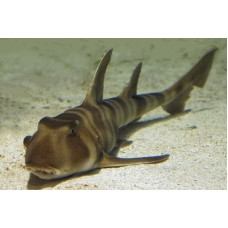Latin name
Heterodontus japonicus
Other name
Heterodontus japonicus
Identification
The Japanese Bullhead has a cylindrical body and a massive head with a blunt and short snout. There are characteristic supraorbital bulges. A shallow notch runs between them on the head. Nictitating membranes are absent. Behind the eyes there are spatulas. The nostrils are framed at the entrance and exit by long flaps of skin that extend to the mouth. The inlets are surrounded by a recess, while another recess connects the outlets to a small mouth at the very tip of the snout.
The front teeth are small and pointed. Each tooth ends in a central point flanked by small lateral teeth. The lateral teeth are larger, elongated, and shaped like molars. There are deep furrows at the corners of the mouth. The skin is covered with large and rough denticles, especially on the sides.
Features of fish fins
Pectoral fins are very large and rounded. The dorsal fins are also rounded, slightly crescent-shaped. The first dorsal fin is larger than the second. Its base begins above the midpoint of the base of the pectoral fins. There is a vertical spine at the base of both dorsal fins. The base of the second dorsal fin is located between the bases of the pelvic and anal fins. The pelvic fins are smaller than the dorsal fins. The anal fin is almost half the size of the two dorsal fins, and its base is posterior to the base of the second dorsal fin. The caudal fin is broad. There is a large ventral notch at the edge of the upper pectoral fin.
Fish colouring
The coloration of the Japanese Bullhead is light brown with 11-14 five dark vague stripes on the main background. There are dark patches under the eyes. There is a sparse pale stripe between the supraorbital ridges.
Distribution
Widespread in the western Pacific Ocean from Japan to the Korean Peninsula and along the coast of China to the island of Taiwan.
Habitat
These bottom dwellers are found on the continental shelf at depths of 6-37 meters and prefer rocky reefs and thickets of brown algae.
Size
The maximum recorded length of these fish is 1.2 meters.
Behavior
Japanese bullheads are slow swimmers that are nocturnal.
Food and feeding habits
Their diet consists mainly of mollusks, crustaceans, small fish and sea urchins. In search of food, these sharks "crawl" along the bottom, supported by large pectoral fins. When they find prey, they extend their jaws, grab it, and crush it with their broad lateral teeth.
Reproduction
Japanese bullheads reproduce by laying eggs that are enclosed in a capsule with a spiral-shaped ridge. At one end is a pair of short antennae. Females lay eggs at depths of 8-9 meters on a rocky bottom or in thickets of algae. Sometimes several females lay eggs in one "nest", which can contain up to 15 eggs. In Japanese waters, females lay a pair of eggs 6-12 times from March to September, with a peak in March and April. It takes about a year from the time the eggs are laid to the time the pups hatch; the newborns are 18 cm long and look very similar to smaller adult sharks, but have a lighter coloration. Males reach sexual maturity at a length of 69 cm.
Fishing
Of little interest as an object of sport fishing.
Relationship with a person
Traumatogenic. These sharks are not dangerous to humans and can be easily caught by divers. They are of minimal interest as a food source in Japan, but are often kept in public aquariums. The International Union for Conservation of Nature has listed this species as "Least Concern".
| Classification | |
| Phylum | Chordata |
| Class | Chondrichthyes |
| Squad | Heterodontiformes |
| Family | Heterodontidae |
| Genus | Heterodontus |
| Species | H. japonicus |
| Features | |
| Conservation status | Least Concern |
| Habitat | Bottom |
| Life span, years | No information |
| Maximum body weight, kg | No information |
| Maximum length, cm | 120 |
| Sailing speed, m/s | No information |
| Threat to people | Edible |
| Way of eating | Predator |
Japanese bullhead shark
Tags: japanese bullhead shark

